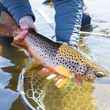If you don’t count any of the newly-added sticks in my vintage rod collection, it’s been a long time since I picked up a new-to-me rod that elicited an honest wow. The Orvis Helios 3D was the last rod I reviewed that made me think, I need one of these for myself, in a few different weights and lengths, just for good measure.
Then, a new Douglas Sky G 9’ 5wt showed up in the mail, and I have once again found myself trying to cook my books to find the money to add one to my quiver. This rod is special.
Like most new, flagship rods, it was built using bleeding-edge technology—in this case, what Douglas calls "G-Tec" platelets (Graphene) added to the Sky G's resin matrix. If you're not familiar with Graphene, at ten times the strength of steel (but with only 5% of the density), graphene is one of the strongest materials known to man. In addition and partially due to its new technology, the Sky G also follows the recent design trend of a more minimalist build approach, in favor of putting more money into blank design and production. In other words, Douglas didn’t spend money trying to make the Sky G sexy, though I’m sure a lot of anglers will appreciate the rod’s muted, subtle craftsmanship.
What makes the Sky G stand out, though, is what the late Tom Morgan once told me all fly rods should do. Tom – who owned Winston and is responsible for them being in Montana – said that the best fly rods are the ones that
fish the best. Never mind whether you can cast it to backing – a rod’s true measure lies in how it acts on the water. In that arena, the Sky G excels and separates itself from its peers.
So, what makes it that great? Let’s take a more detailed look.




























